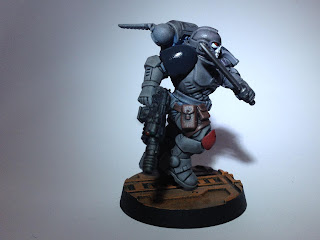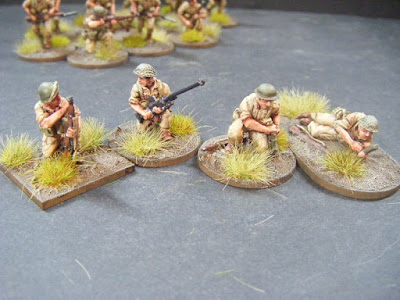Back to work means painting time gets slashed, so this is a small entry that was largely done before work resumed.
Because I have been a good boy (and the evidence to the contrary has been heavily redacted), Santa brought me something for GW's Kill Team for Christmas - the Fangs of Ulfrich box set (where do they get these names from!), which included a 5-man Reiver squad. Although the backstory in the box was for Space Wolves, I am not a fan of the powder blue look, so looked elsewhere for inspiration. I decided on a colour scheme with, apart from the skull mask and the right knee pad, variations on grey, the idea being that the terror they inspire is accentuated by them being concealed in and then emerging from the shadows. The shoulder pad skull insignia was inspired by modern day special forces sporting 'Punisher' patches, so these Marines are from the Punishers Chapter, terminating the brief of all transgressors with extreme prejudice. Finally, the Spec Ops look was finished off by adding suppressors and laser pointers on all the weapons, with reflex sights on the carbines as well. These items were all from Anvil Industries and are really crisp resin pieces that fit perfectly onto the GW parts.
First up we have the squad's leader. He was originally going to have a pistol and knife combo, but whilst putting these together I watched Equalizer 2. Whilst not as good as the first Equalizer movie, there is a scene where Denzil W takes out one of the bad guys with two knives, and so this pose was born.
Next we have two pistol and knife armed Marines. All of them are based on GW Necromunda bases - I have never used moulded bases like these before but am very happy with how they look, plus they come up nicely with a drybrush, so are nice and quick to do. I did them to match the industrial terrain that came in the box set.
Finally we have two Marines armed with suppressed carbines. I did try to pose one as if he was actually looking through his reflex sight, but it was beyond me; clearly he has got close enough that he can just blast away down range! You will also note that one is without helmet and backpack - he came off second best in a canine ambush. I don't have any more Primaris backpacks and didn't want to use an older style one, so will have to source a replacement off of Ebay. Luckily there were several alternative heads, but no more in full helmets (WHY would you take off your helmet? The grimdark future is dangerous!); clearly he is just nails!
Finally, we have a standard bearer for the Bolsheviks from last week. The figure is Copplestone Castings again; in the photo he is quite shiny, even though in the flesh (metal?) he is not. The banner was downloaded from a website with a small selection of Russian Civil War flags and apparently translates as 'Freedom From White Oppression'. The flags have been inspired by information from the Pygmy Wars website - thoroughly recommended if you are at all interested in the RCW/Back of Beyond.
Not quite sure of points due to the missing backpack on the Reiver, so I shall defer to the wisdom of the mighty, witty and devilishly handsome Tuesday Minion.
Flattery will get you everywhere Peter! A great looking kill team and I like the colour team you have gone for on these. Don't worry about the missing backpack, just gives that one guy a backstory ("I only it down for a second.."). The Bolshevik with the flag is an impressive figure and that flag looks excellent.
Six 28mm figures will get you 30 points and an extra for the flag brings this up to 31 points.


























































